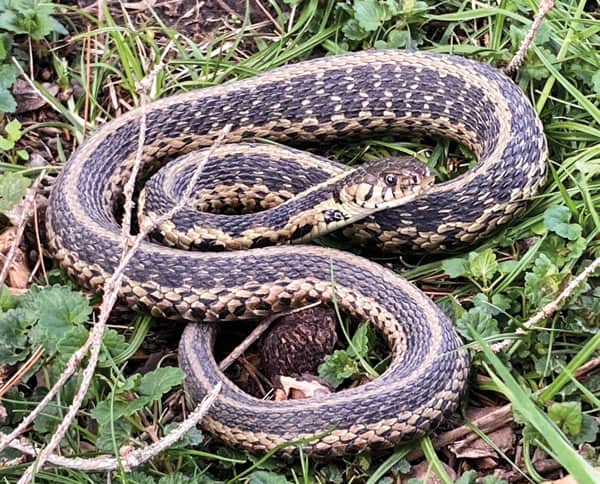As summer approaches, many will have hands in the dirt pulling weeds. Coming across a snake in the grass or dirt may startle even the bravest and could result in a failed garden for the fainthearted. There’s no reason to fear snakes in your garden. Most are harmless and many provide valuable ecosystem services, eating the pests you loathe even more than snakes.
Three snakes commonly found in gardens across most of Illinois are, from smallest to largest, DeKay’s brownsnake, Eastern garter snake, and gray ratsnake.
Moving a board on the ground or an old pile of shingles, you might come across a DeKay’s brownsnake (pictured above), a mere 9–13-inch-long snake with a very small home range. In a year, this snake might move only 200 feet from your garden to a neighbor’s woodpile. Brownsnakes primarily eat earthworms, slugs and snails, using their tiny, slender teeth to extract snails from their shells. Keeping this slug predator around could be beneficial to your hostas and other prized plants.

Eastern garter snakes are ubiquitous in Illinois. You may find them under debris in the yard or hunting toads in the garden. While this larger (16–26 inch) snake will eat worms and snails, it often munches on larval and adult toads, frogs and salamanders. Remarkably, garter snakes can tolerate poisons in the skin of these animals. Two to four suburban backyards could be home to 10–20 garter snakes, or more if water is nearby. A garter snake basking on your stone wall will add some color and pattern to your garden and, because no two snakes are exactly alike, the more the better!
Gray ratsnakes are much more conspicuous in their environment, being a fairly large snake (42–72 inches), and tend to climb trees and rocks. Young snakes are blotched until they reach about 3 feet in length, at which point their pattern fades to a gray or black appearance. Ratsnakes can help control rodent populations and an intrepid one may follow a mouse into your house. One ratsnake could range across an entire neighborhood, but the amount of area they cover will depend on food availability. It may appear menacing, even vibrating its tail in leaf litter when disturbed, but it is completely harmless.

Are you lucky enough to share your space with any of these gentle snakes? If in your way, you may safely move without fear of being injured. These species rarely attempt to bite humans, none are venomous, and they cannot penetrate garden gloves with their teeth. A nudge from the handle of your hoe, rather than a chop, will also motivate a snake to move out of your path. If you allow these three species to share your garden space, I am almost certain good karma will follow and I guarantee the snakes will thank you!
I am eager to learn about your efforts to have a peaceful coexistence with our reptilian friends. Contact me at jmokeefe@illinois.edu.
Photos of DeKay’s brownsnake and juvenile gray ratsnake courtesy of John Palis.










